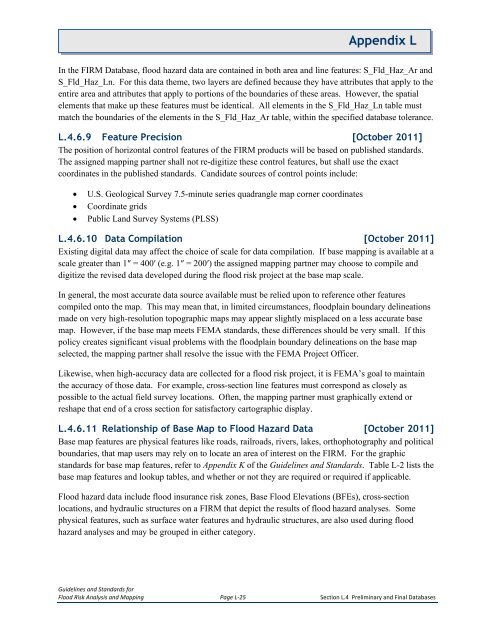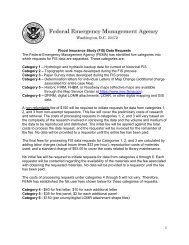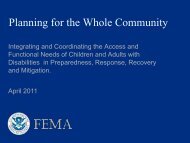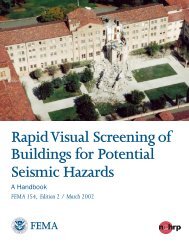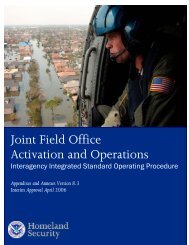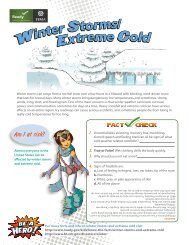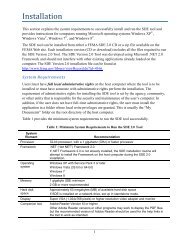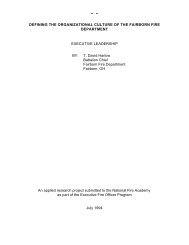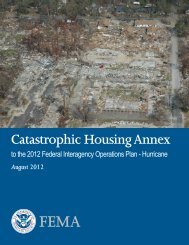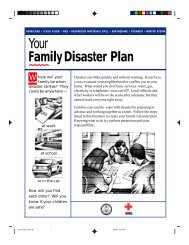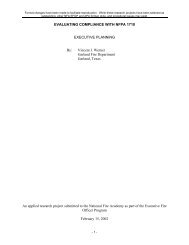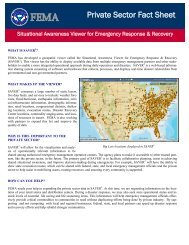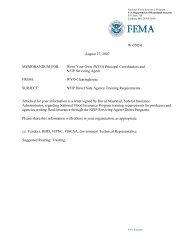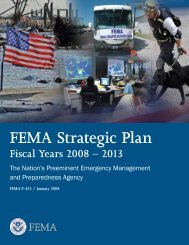Appendix L - Federal Emergency Management Agency
Appendix L - Federal Emergency Management Agency
Appendix L - Federal Emergency Management Agency
You also want an ePaper? Increase the reach of your titles
YUMPU automatically turns print PDFs into web optimized ePapers that Google loves.
<strong>Appendix</strong> LIn the FIRM Database, flood hazard data are contained in both area and line features: S_Fld_Haz_Ar andS_Fld_Haz_Ln. For this data theme, two layers are defined because they have attributes that apply to theentire area and attributes that apply to portions of the boundaries of these areas. However, the spatialelements that make up these features must be identical. All elements in the S_Fld_Haz_Ln table mustmatch the boundaries of the elements in the S_Fld_Haz_Ar table, within the specified database tolerance.L.4.6.9 Feature Precision [October 2011]The position of horizontal control features of the FIRM products will be based on published standards.The assigned mapping partner shall not re-digitize these control features, but shall use the exactcoordinates in the published standards. Candidate sources of control points include:• U.S. Geological Survey 7.5-minute series quadrangle map corner coordinates• Coordinate grids• Public Land Survey Systems (PLSS)L.4.6.10 Data Compilation [October 2011]Existing digital data may affect the choice of scale for data compilation. If base mapping is available at ascale greater than 1″ = 400′ (e.g. 1″ = 200′) the assigned mapping partner may choose to compile anddigitize the revised data developed during the flood risk project at the base map scale.In general, the most accurate data source available must be relied upon to reference other featurescompiled onto the map. This may mean that, in limited circumstances, floodplain boundary delineationsmade on very high-resolution topographic maps may appear slightly misplaced on a less accurate basemap. However, if the base map meets FEMA standards, these differences should be very small. If thispolicy creates significant visual problems with the floodplain boundary delineations on the base mapselected, the mapping partner shall resolve the issue with the FEMA Project Officer.Likewise, when high-accuracy data are collected for a flood risk project, it is FEMA’s goal to maintainthe accuracy of those data. For example, cross-section line features must correspond as closely aspossible to the actual field survey locations. Often, the mapping partner must graphically extend orreshape that end of a cross section for satisfactory cartographic display.L.4.6.11 Relationship of Base Map to Flood Hazard Data [October 2011]Base map features are physical features like roads, railroads, rivers, lakes, orthophotography and politicalboundaries, that map users may rely on to locate an area of interest on the FIRM. For the graphicstandards for base map features, refer to <strong>Appendix</strong> K of the Guidelines and Standards. Table L-2 lists thebase map features and lookup tables, and whether or not they are required or required if applicable.Flood hazard data include flood insurance risk zones, Base Flood Elevations (BFEs), cross-sectionlocations, and hydraulic structures on a FIRM that depict the results of flood hazard analyses. Somephysical features, such as surface water features and hydraulic structures, are also used during floodhazard analyses and may be grouped in either category.Guidelines and Standards forFlood Risk Analysis and Mapping Page L-25 Section L.4 Preliminary and Final Databases


